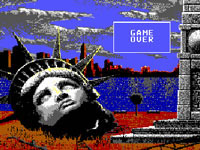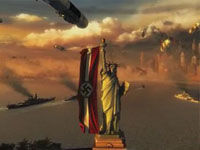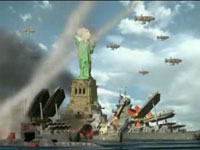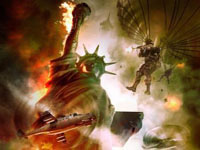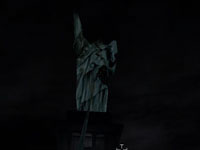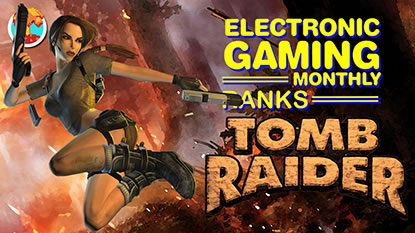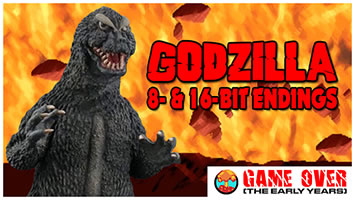- CLASSIC MAGAZINES
- REVIEW CREW
A show recapping what critics thought back
when classic games first came out! - NEXT GENERATION'S BEST & WORST
From the worst 1-star reviews to the best
5-stars can offer, this is Next Generation! - NINTENDO POWER (ARCHIVE)
Experience a variety of shows looking at the
often baffling history of Nintendo Power! - MAGAZINE RETROSPECTIVE
We're looking at the absolutely true history of
some of the most iconic game magazines ever! - SUPER PLAY'S TOP 600
The longest and most ambitious Super NES
countdown on the internet! - THEY SAID WHAT?
Debunking predictions and gossip found
in classic video game magazines! - NEXT GENERATION UNCOVERED
Cyril is back in this spin-off series, featuring the
cover critic review the art of Next Generation! - HARDCORE GAMER MAGAZING (PDF ISSUES)
Download all 36 issues of Hardcore Gamer
Magazine and relive the fun in PDF form!
- REVIEW CREW
- ELECTRONIC GAMING MONTHLY
- ELECTRONIC GAMING MONTHLY RANKS
From Mario to Sonic to Street Fighter, EGM
ranks classic game franchises and consoles! - ELECTRONIC GAMING MONTHLY BEST & WORST
Counting down EGM’s best and worst reviews
going year by year, from 1989 – 2009! - ELECTRONIC GAMING BEST & WORST AWARDS
11-part video series chronicling the ups and
downs of EGM’s Best & Worst Awards!
- ELECTRONIC GAMING MONTHLY RANKS
- GAME HISTORY
- GAME OVER: STORY BREAKDOWNS
Long-running series breaking down game
stories and analyzing their endings! - A BRIEF HISTORY OF GAMING w/ [NAME HERE]
Real history presented in a fun and pithy
format from a variety of game historians! - THE BLACK SHEEP
A series looking back at the black sheep
entries in popular game franchises! - INSTANT EXPERT
Everything you could possibly want to know
about a wide variety of gaming topics! - FREEZE FRAME
When something familiar happens in the games
industry, we're there to take a picture! - I'VE GOT YOUR NUMBER
Learn real video game history through a series
of number-themed episodes, starting at zero! - GREAT MOMENTS IN BAD ACTING
A joyous celebration of some of gaming's
absolute worst voice acting!
- GAME OVER: STORY BREAKDOWNS
- POPULAR SHOWS
- DG NEWS w/ LORNE RISELEY
Newsman Lorne Riseley hosts a regular
series looking at the hottest gaming news! - REVIEW REWIND
Cyril replays a game he reviewed 10+ years
ago to see if he got it right or wrong! - ON-RUNNING FEUDS
Defunct Games' longest-running show, with
editorials, observations and other fun oddities! - DEFUNCT GAMES QUIZ (ARCHIVE)
From online quizzes to game shows, we're
putting your video game knowledge to the test!- QUIZ: ONLINE PASS
Take a weekly quiz to see how well you know
the news and current gaming events! - QUIZ: KNOW THE GAME
One-on-one quiz show where contestants
find out if they actually know classic games! - QUIZ: THE LEADERBOARD
Can you guess the game based on the classic
review? Find out with The Leaderboard!
- QUIZ: ONLINE PASS
- DEFUNCT GAMES VS.
Cyril and the Defunct Games staff isn't afraid
to choose their favorite games and more! - CYRIL READS WORLDS OF POWER
Defunct Games recreates classic game
novelizations through the audio book format!
- DG NEWS w/ LORNE RISELEY
- COMEDY
- GAME EXPECTANCY
How long will your favorite hero live? We crunch
the numbers in this series about dying! - VIDEO GAME ADVICE
Famous game characters answer real personal
advice questions with a humorous slant! - FAKE GAMES: GUERILLA SCRAPBOOK
A long-running series about fake games and
the people who love them (covers included)! - WORST GAME EVER
A contest that attempts to create the worst
video game ever made, complete with covers! - LEVEL 1 STORIES
Literature based on the first stages of some
of your favorite classic video games! - THE COVER CRITIC
One of Defunct Games' earliest shows, Cover
Critic digs up some of the worst box art ever! - COMMERCIAL BREAK
Take a trip through some of the best and
worst video game advertisements of all time! - COMIC BOOK MODS
You've never seen comics like this before.
A curious mix of rewritten video game comics!
- GAME EXPECTANCY
- SERIES ARCHIVE
- NINTENDO SWITCH ONLINE ARCHIVE
A regularly-updated list of every Nintendo
Switch Online release, plus links to review! - PLAYSTATION PLUS CLASSIC ARCHIVE
A comprehensive list of every PlayStation
Plus classic release, including links! - RETRO-BIT PUBLISHING ARCHIVE
A regularly-updated list of every Retro-Bit
game released! - REVIEW MARATHONS w/ ADAM WALLACE
Join critic Adam Wallace as he takes us on a
classic review marathon with different themes!- DEFUNCT GAMES GOLF CLUB
Adam Wallace takes to the links to slice his way
through 72 classic golf game reviews! - 007 IN PIXELS
Adam Wallace takes on the world's greatest spy
as he reviews 15 weeks of James Bond games! - A SALUTE TO VAMPIRES
Adam Wallace is sinking his teeth into a series
covering Castlevania, BloodRayne and more! - CAPCOM'S CURSE
Adam Wallace is celebrating 13 days of Halloween
with a line-up of Capcom's scariest games! - THE FALL OF SUPERMAN
Adam Wallace is a man of steel for playing
some of the absolute worst Superman games! - THE 31 GAMES OF HALLOWEEN
Adam Wallace spends every day of October afraid
as he reviews some of the scariest games ever! - 12 WEEKS OF STAR TREK
Adam Wallace boldly goes where no critic has
gone before in this Star Trek marathon!
- DEFUNCT GAMES GOLF CLUB
- DAYS OF CHRISTMAS (ARCHIVE)
Annual holiday series with themed-episodes
that date all the way back to 2001!- 2015: 30 Ridiculous Retro Rumors
- 2014: 29 Magazines of Christmas
- 2013: 29 Questionable Power-Ups of Christmas
- 2012: 34 Theme Songs of Christmas
- 2011: 32 Game Endings of Christmas
- 2010: 31 Bonus Levels of Christmas
- 2009: 30 Genres of Christmas
- 2008: 29 Controls of Christmas
- 2007: 34 Cliches of Christmas
- 2006: 33 Consoles of Christmas
- 2005: 32 Articles of Christmas
- 2004: 31 Websites of Christmas
- 2003: 29 Issues of Christmas
- 2002: 28 Years of Christmas
- 2001: 33 Days of Christmas
- NINTENDO SWITCH ONLINE ARCHIVE
- REVIEW ARCHIVE
- FULL ARCHIVE
Destroying Lady Liberty
CHAPTER 2: "THEY HATE LIBERTY"
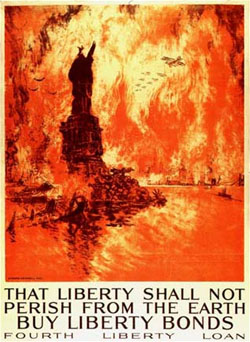
It's hard to come up with a witty come back for a picture of the Statue of Liberty on fire!
The short answer to the first question is no. Destroying American landmarks is not unpatriotic. If anything, dystopian landscapes can reveal a deep love of country; they can serve as warnings against bad policies, fractured national identity, or a reminder of the fragility of democracy. In 1918, when American artist Joseph Pennell painted a maimed and beheaded Statue of Liberty against a backdrop of a burning city, he did so to motivate U.S. citizens to buy war bonds. Today, it remains among the most admired propaganda pieces from World War I.
Yet, there still must be some angst-appeal for some gamers and even for the developers themselves. When discussing Turning Point: The Fall of Liberty, the latest title to employ the Statue in a dystopian vision, producer Dean Martinelli speaks of destroying iconic landmarks with a glee in voice that verges on being scary. In a preview of the title, Mr. Martinelli says "We actually took photos of the White House interior and built the sets to be exact ... That's cool because you get to go into the White House and shoot it up." Is he applauding the accuracy of the game's layout or is it something more sinister? Perhaps it is both. Since the success of the 1986 arcade smash-em-up Rampage, game developers have known that players are drawn to enacting destructive fantasies. Whether these rampages are simply cathartic exercises in power or anarchistic fantasies remains to be determined.
New York Warriors (1990, Amiga): Death seems scarier when the deceased has her eyes opened in that faraway, unbroken stare. Whenever the Statue is decapitated in fiction, its open-eyed, blank, stoic, expressions helps to make the image resonate with the viewer. Using graphics impressive for its time, the "game over" screen for New York Warriors shows you the fruits of your failure: Liberty's head in silent repose. When you lose, you don't just lose; you are made to feel extremely guilty for letting your country down. This dystopian game proves once again the efficacy of using the colossal statue as a measure of social destruction. Even though your mission is to dismantle a nuclear device planted in The World Trade Center, the game's box art and advertisements focus most intently on the Statue.
Shattered Union (2005, Xbox, PC): The tilting Statue on the box for Shattered Union tells you all you need to know about the game. American democracy has fallen to tyrannical rule leading to a factious nation and then to all-out civil war. In this hex-based strategy game, the Statue remains intact, but you can bomb it and gain points for its destruction. The box art for the game was eventually changed to show a post-nuclear Washington, D.C., a good decision on part of 2K Games since the capitol city has more to do with the initial story than does New York or San Francisco. If you're one those people that doesn't like George W. Bush and you curse his name whenever you wake up late for work and your car doesn't start, then you should play Shattered Union and look at the aftermath of David Jefferson Adams' presidency.
Turning Point: Fall of Liberty (2008, Multiple): A what-if World War II story, Turning Point does not obliterate the Statue physically, but the juxtaposition of the red Nazi flag against the copper green inflicts an equally devastating blow by negating her promise of accepting all peoples from all over the world. It was smart of the game's developers to keep the Statue intact. Joseph Goebbles, propaganda minister for Hitler, would have likely done so in order to create an impression of unification and goodwill with the U.S. After all, when Germany marched into France, they didn't necessarily topple the Eiffel Tower and erect a V2 Rocket in its place. They wanted the French to eventually assimilate into Aryan culture. The transition, however, does not run smoothly in the U.S., and tough and tumble New Yorkers like construction worker Dan Carson prove that Americans do not take kindly to uninvited guests.
Command & Conquer: Red Alert (2001, PC): Whenever an invading force enters foreign territory, symbolic targets are just as important as military ones. The toppling of statues effects the morale of the enemy and can be more effective than sinking a fleet of aircraft carriers. So, it is not surprising to have the Soviets first swarming around the Hudson River to take out the allegorical figure of our freedoms. The ad campaign for this alternate reality strategy game was somewhat thwarted by the events of September 11th, 2001. Since the game was released almost a year before the Al-Qaeda terrorist attacks, the Pentagon and World Trade Center are still viable targets in gameplay, but EA smartly adjusted the game's packaging to match the national mood.
World in Conflict (2007, PC): Sweden is famous for its neutrality in war, yet Swedish software developer Massive Entertainment brings us another what-if Cold War scenario. The initial Soviet invasion occurs on the West Coast, but the inevitable raid on New York Harbor comes later in the game. If you lose the mission to protect Liberty Island, you see the Statue obliterated by a Soviet air strike. Most notably, as the Statue topples, an American G.I. can be seen vomiting in the foreground. This moment shows a sophistication and maturity often unseen in gaming. It perfectly captures the spiritual nausea that such a catastrophe would cause. The developers should be commended for getting the psychological impact of Liberty's destruction right.
Deus Ex (2000, PS2, PC): It is 2050 and the world is ravaged by terrorism and viral outbreak. The Deus Ex series begins at Liberty Island, the home-base for an international military force "formed by executive order after the terrorist strike on the Statue." The headless statue figures prominently in the game and there seems to be no rush to repair it since it serves as a constant reminder of why the world needs a counter-terrorist team. J.C. Denton, a member of this team, must unravel international conspiracies and unveil the sinister plots of several shadow-government factions. The game is highly philosophical and well-researched in modern conspiracy theories.
The sequel, Deus Ex: Invisible Wars, bookends the initial images of the headless Liberty nicely by ending the game with the image of a reconstructed statue constructed of light, perhaps taking its cue from the real-life "Towers of Light" memorial that shone in place of the World Trade Center in 2002.
HOME |
CONTACT |
NOW HIRING |
WHAT IS DEFUNCT GAMES? |
NINTENDO SWITCH ONLINE |
RETRO-BIT PUBLISHING
Retro-Bit |
Switch Planet |
The Halcyon Show |
Same Name, Different Game |
Dragnix |
Press the Buttons
Game Zone Online | Hardcore Gamer | The Dreamcast Junkyard | Video Game Blogger
Dr Strife | Games For Lunch | Mondo Cool Cast | Boxed Pixels | Sega CD Universe | Gaming Trend
Game Zone Online | Hardcore Gamer | The Dreamcast Junkyard | Video Game Blogger
Dr Strife | Games For Lunch | Mondo Cool Cast | Boxed Pixels | Sega CD Universe | Gaming Trend
Copyright © 2001-2024 Defunct Games
All rights reserved. All trademarks are properties of their respective owners.
All rights reserved. All trademarks are properties of their respective owners.







